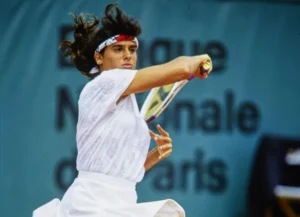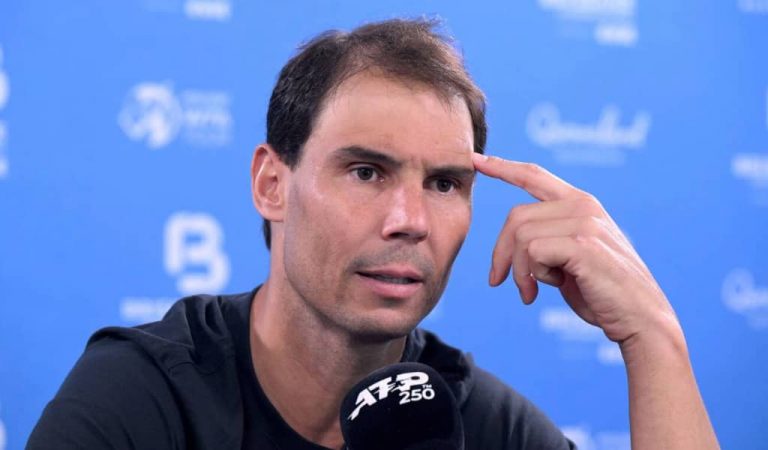Latin Women in Sports: Gabriela Sabatini is Latin America’s Best Tennis Player Ever
Latin America has long been a hotbed for sporting talent, producing legendary athletes in disciplines ranging from soccer and baseball to boxing and gymnastics. Yet, the tennis court—a domain often dominated by European and North American stars—has not traditionally been the first place you’d look for Latin American excellence. Enter Gabriela Sabatini, the Argentine tennis prodigy who not only redefined the region’s presence in international tennis but also became an enduring symbol of elegance, grit, and sporting excellence.
Born in Buenos Aires on May 16, 1970, Sabatini carved her name in history as one of the most influential and successful Latin American tennis players. Her achievements are a testament to her exceptional talent and her ability to navigate the global pressures of professional tennis at a time when opportunities for women in the sport, particularly from Latin America, were limited.
The Early Years: A Rising Star
Gabriela Sabatini’s journey in tennis began when she was just six years old. By the time she turned 10, her extraordinary skill set her apart from her peers, winning her a slew of junior championships. In 1983, at the age of 13, she became the youngest player to win the prestigious Orange Bowl in Miami, a renowned junior tennis tournament. This victory marked the beginning of her ascent to stardom.
What made Sabatini unique was not just her technical finesse—her powerful groundstrokes and silky one-handed backhand—but also her poise under pressure. Unlike many teenage prodigies who buckle under the weight of expectations, Sabatini thrived, using her early exposure to high-level competition as a stepping stone to greater accomplishments.
Breaking into the Elite: Grand Slam Glory

Sabatini turned professional in 1985 at just 15 years old, quickly making an impression on the WTA Tour. Her graceful yet aggressive playing style stood out in a field dominated by fierce competitors like Steffi Graf, Martina Navratilova, and Chris Evert. She reached her first Grand Slam semifinal at the French Open in 1985, becoming one of the youngest players ever to achieve such a feat.
But it was her rivalry with Steffi Graf, the indomitable German champion, that defined much of Sabatini’s career. The two faced off in numerous high-stakes matches, including the 1988 US Open final. While Sabatini lost that particular contest, it set the stage for her crowning achievement: winning the 1990 US Open.
In that iconic final, Sabatini defeated Graf in straight sets (6–2, 7–6), showcasing her ability to outmaneuver one of the most dominant players in tennis history. That victory not only secured her place among the sport’s elite but also made her the first—and, to date, only—Argentine woman to win a Grand Slam singles title in the Open Era.
Beyond Singles: Doubles Dominance
Sabatini wasn’t just a force in singles; she was equally accomplished in doubles. She partnered with Steffi Graf to win the Wimbledon doubles title in 1988, a rare instance of two fierce rivals collaborating to achieve greatness. Her versatility and adaptability on the court were evident in her doubles play, where her tactical acumen and powerful baseline game complemented her partners’ strengths.
Throughout her career, Sabatini won 14 doubles titles, including major victories and appearances in finals across all four Grand Slam tournaments. This versatility further cements her legacy as one of the most complete players in tennis history.
Latin America’s Trailblazer
While her on-court achievements are legendary, Sabatini’s impact goes far beyond her trophy cabinet. She became a role model for aspiring Latin American athletes, proving that it was possible to excel in a sport traditionally dominated by wealthier nations with greater resources. Her success inspired a generation of Latin American tennis players, including the likes of Gustavo Kuerten, Juan Martín del Potro, and more recently, Diego Schwartzman.
Off the court, Sabatini carried herself with grace and humility, winning over fans and fellow players alike. Her warm personality, coupled with her tenacity and elegance on the court, made her a global ambassador for tennis and for Latin America.
Post-Retirement Legacy
Gabriela Sabatini retired from professional tennis in 1996 at the age of 26—a decision that surprised many, given her relatively young age. However, by the time she left the sport, she had already achieved more than most players dream of in a lifetime: a Grand Slam singles title, 27 career singles titles, 14 doubles titles, and a Silver Medal from the 1988 Olympics.
Retirement didn’t mean stepping away from the spotlight. Sabatini transitioned seamlessly into a career as a businesswoman and philanthropist. She launched a successful line of perfumes that has become a global brand, blending her passion for elegance with entrepreneurship.
Moreover, she has remained deeply connected to tennis and charitable causes. Through various initiatives, she has worked to provide opportunities for underprivileged children in Argentina, ensuring that her legacy isn’t just one of personal success but also of giving back.
Why Gabriela Sabatini Is Latin America’s Best Tennis Player Ever
Gabriela Sabatini’s accomplishments on the tennis court, combined with her trailblazing role as a Latin American woman in a global sport, make her a unique and enduring figure in sports history. While other Latin American players have achieved greatness, few, if any, have matched her combination of skill, consistency, and influence.
Consider the context of her career: Sabatini competed during one of the most competitive eras in women’s tennis, facing legends like Graf, Navratilova, and Monica Seles. Despite the stiff competition, she carved out a remarkable career, highlighted by her Grand Slam triumph and numerous high-profile victories.
Beyond her records, Sabatini’s influence transcends numbers. She brought a new level of recognition to Latin American tennis, paving the way for future generations. Her success demonstrated that Latin American athletes could compete at the highest levels of tennis, inspiring countless players to pick up a racket and dream big.
The Enduring Legacy of a Champion
Today, Gabriela Sabatini remains a revered figure in the sports world. Her achievements continue to resonate, serving as a reminder of the heights Latin American athletes can reach with determination, talent, and hard work.
Her story is one of perseverance, elegance, and breaking barriers—a testament to the power of sport to transcend borders and inspire. Gabriela Sabatini isn’t just Latin America’s best tennis player; she’s a global icon, a trailblazer, and a role model for athletes everywhere.
As Latin America continues to produce world-class talent in tennis and beyond, Gabriela Sabatini’s legacy stands tall, reminding us all of what is possible when passion meets excellence.



